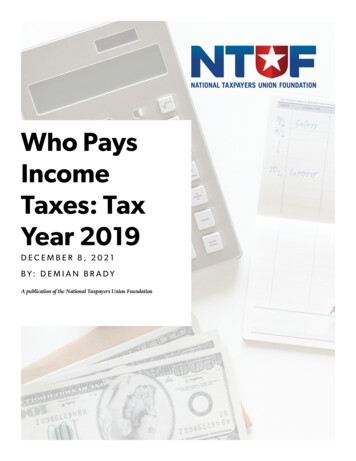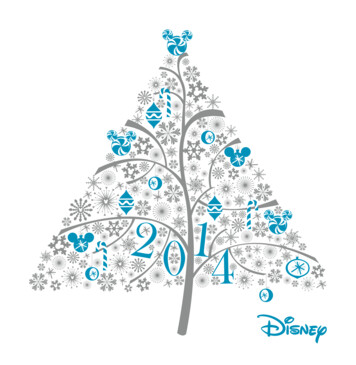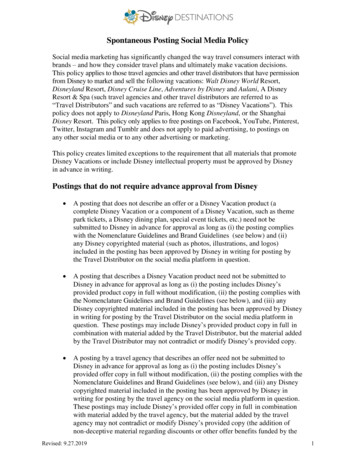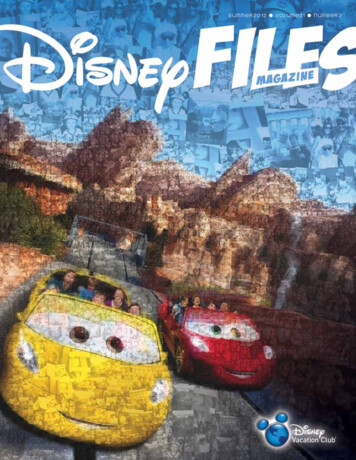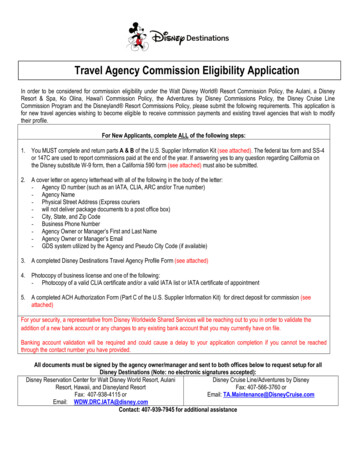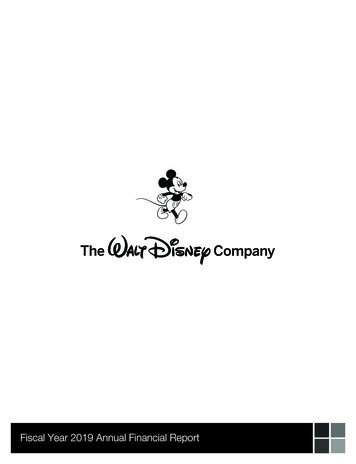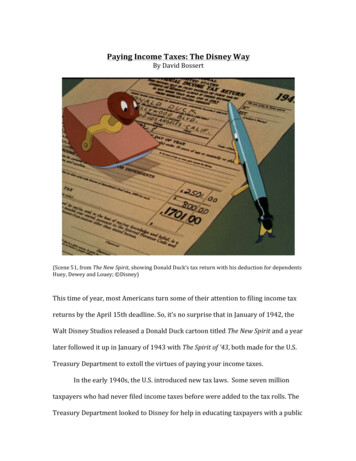
Transcription
Paying Income Taxes: The Disney WayBy David Bossert(Scene 51, from The New Spirit, showing Donald Duck’s tax return with his deduction for dependentsHuey, Dewey and Louey; Disney)This time of year, most Americans turn some of their attention to filing income taxreturns by the April 15th deadline. So, it’s no surprise that in January of 1942, theWalt Disney Studios released a Donald Duck cartoon titled The New Spirit and a yearlater followed it up in January of 1943 with The Spirit of ’43, both made for the U.S.Treasury Department to extoll the virtues of paying your income taxes.In the early 1940s, the U.S. introduced new tax laws. Some seven milliontaxpayers who had never filed income taxes before were added to the tax rolls. TheTreasury Department looked to Disney for help in educating taxpayers with a public
service announcement (PSA) for the movie theaters and the studio was alreadystarting to do other films for various branches of the U. S. government. In a telegramto Walt Disney, his brother Roy O. Disney said, “will discuss matter of having us[studio] designated as a defense plant per your wire and see what we can do.” TheDisney Studios became a major supplier of training films, PSAs and educational filmsto the U.S. Government during World War II.Shortly after the bombing of Pearl Harbor, Treasury Secretary HenryMorganthau, Jr. wanted a Disney-created “Mr. Average Taxpayer” character to helpconvey the importance of paying your taxes in the first of two shorts. But WaltDisney argued for Donald Duck as the spokesman, his most popular character at thattime. Disney likened Donald Duck to lending out a leading movie star like ClarkGable to help educate the public in the theatres. Walt ultimately prevailed in hisargument and Donald Duck became an advocate for paying income taxes.Calling long distance from Washington D.C. on Thursday, December 18, 1941,Walt Disney spoke to story man Joe Grant and director Ben Sharpsteen about thenew tax picture. Walt explained, “The treasury dept. wants us to make a film. This abig order. By that I mean it is a tough job to handle. It is to be a film with DonaldDuck making people like the fact that they have to pay income tax. It is going to tellhow the tax problem plays its part in this war.” He continued, “The Treasury Dept.wants to put on a nationwide campaign before March 15 and this film will be run inall theatres.” The phone call continued with ideas for what the storyline would befor this first tax picture and they also briefly talked about other matters includingdoing a PSA for war bonds.
“They need all the help we can give them and they are anxious to get it,” saidWalt.“We will first work on the income tax film and then the bonds,” said Grant.“Stick to the Donald Duck film as the main idea. Donald talks to the radiovoice and between them they tell the story of the income taxes. This means that wewill be running into over-time but we’ve got to move it through. We must pull outour best men for this thing regardless of what they are doing,” said Walt, “I want thebest men and the men who can work with speed and economy. Don’t forget that weare making this on a cost basis and this film will have to cost as little as possible.”(The title cards for The New Spirit and The Spirit of ’43; Disney)It was the Treasury Secretary whom unknowingly came up with the title ofthe film. Walt explained in the call, “The Secretary suggested this thought it was anew spirit. That might be a good title for this picture.”Walt’s conversation with Treasury Secretary Morganthau to do this film wasessentially done on a handshake. There was no formal agreement initially spellingout the terms, only that Disney would do the film at cost. This arrangement wouldcome back on Walt. When he went back to the Treasury for payment, Morganthau
had to go to Congress to have the funds appropriated. That caused a dust up withsome Senators accusing Walt of war profiteering. Ultimately, the Senate approvedthe funding. Roy did admonish Walt and stressed the need to get proper contracts inplace beforehand with the terms spelled out.Despite the bad press in the Senate surrounding The New Spirit it receivedgenerally favorable reviews. The Chicago Tribune’s drama critic Ashton Stevenssaid, “When a movie laughs you into paying making out an income-tax return—andborrowing money to pay it on the line, that isn’t just pecuniary propaganda—that’smagic that partakes of the miraculous.” Thornton Delehanty of The New York Heraldwrote, “Walt Disney’s first production for the Treasury Department should go anincalculable way toward easing the grief and dismay with which the publiccustomarily views its income taxes.” The film was nominated for Best Documentaryat the Academy Awards in 1943.It is worth noting, that from the time Walt phoned Grant and Sharpsteen onDecember 18th to discuss the first tax picture story ideas, it took only about sixweeks to complete The New Spirit and have prints struck at Technicolor. The fullrunning time of the short is 7 minutes 21 seconds with a total 662 feet of animation.Of that, roughly 389 feet is the Donald Duck animation portion with the remainderof the film done in limited animation, camera moves on still art with optical effectsand voiceover. Some of that animation is re-use including the whirlpool from TheSorcerer’s Apprentice, which is painted black, white and gray and swallows aswastika. It was common for Walt to re-use animation for these government fundedfilms, it saved time and expense.
After the dustup in the Senate over appropriating funds to pay for The NewSpirit had settled down, Jack King, a key animation director at the studio duringthose early years, was named director of the tax picture sequel, The Spirit of ‘43. Hehad assigned several animators to the project including Disney legend WardKimball. By this time, Kimball had established himself as a premiere animator at thestudio with his work on Snow White and Seven Dwarfs, his design and animation ofJiminy Cricket for Pinocchio, and Bacchus along with his pet unicorn-donkey inFantasia.Joe Grant and Carl Barks were assigned to develop the story for The Spirit of’43. Joe was noted for his strong story sense and had developed the storylines forDumbo, Der Fuehrer’s Face, Thru the Mirror, as well as the first tax picture The NewSpirit. Carl was best known for his work on the Donald Duck comics and is creditedas the writer on numerous Donald Duck shorts including Donald’s Nephews, TheHockey Champ, Sea Scouts, and Chef Donald, among others.(Donald Duck’s thrifty self from The Spirit of ’43 is an early predecessor to Uncle Scrooge McDuck; Disney)
The storyline for The Spirit of ’43 consists of Donald being torn between hisspendthrift self and his more practical, thrifty self portrayed by a Scotsman thatlooks very much like a predecessor to Uncle Scrooge McDuck. The story for thisshort is a classic good vs. evil scenario. Good triumphs in the end, as it alwaysshould, with Donald racing off to the IRS office in Washington, D.C., to pay his taxes.(Scene 71, from The New Spirit, shows a row of Uncle Sam factory whistles blowing; Disney)The last half of the previous years The New Spirit was reused in The Spirit of’43 based on the Treasury Departments request. Roy advised against the reuse,saying in a telegram to Walt that, “Regarding Treasury requests for some newmaterial and there plans to reuse last half of New Spirit I recommend that youadvise against any secondary use of New Spirit principally on the basis that its
effectiveness because of reuse of old material which will be recognized will belessened with the public and for that reason is poor economy.” He alsorecommended that the film be short because, “ with so many Government picturescrowding the screen time message can better put over by being short.” It’s clear thatthe Treasury got its way reusing the material from the last half, but The Spirit of ’43is shorter film than The New Spirit.The Spirit of ’43 is also considered to be a stronger film than The New Spiritbecause Donald Duck is better as a character when he has an antagonist to workagainst, which is what made so many of the Donald shorts terrific, especially whenhe was pitted against Chip and Dale. In The New Spirit, it is just Donald and a radioannouncer whereas in The Spirit of ’43 he plays off the spendthrift and the thriftyversions of himself. Also, the humorous gags are much stronger in this second film,which helps reinforce the message of paying your income taxes.Clarence Nash does the voice of Donald Duck and Cliff Edwards, mostfamously known as the voice of Jiminy Cricket, does the singing voice over in bothfilms. Fred Shields does the radio announcer voice in The New Spirit. Shields alsoprovided the narrator voice for many Disney shorts including Donald’s Decision,Saludos Amigos, How to Play Baseball, How to Play Golf, El Gaucho Goofy, VictoryVehicles, Food Will Win the War, and many others.Although these films were made as PSAs for paying your taxes, the re-usesecond half of the films falls into U.S. government propaganda. It was designed toinspire as well as bolster morale for the righteousness of America’s war effort. Itwas a different era when the entire country rallied against a common enemy, which
defined what is now referred to as the “greatest generation” and the artists at theDisney studios played their part in that effort.(The war planes and military vehicles cycle as the clouds and stars form an American flag in the skyat the end of both The New Spirit and The Spirit of ’43, as the narrator says, “This is our fight thefight for freedom freedom of speech, of worship freedom from want and fear taxes will keepdemocracy on the march!” The Sportsmen Quartet softly sings ‘My Country, 'Tis of Thee’ in thebackground; visual concept by Joe Grant; Disney)During that period, the Disney Studios relied heavily on these governmentfunded projects to help keep the studio financially afloat. It allowed Walt to retainemployees he might otherwise have had to let go during the wartime economy. Atthe same time, those that worked on these shorts could take pride in theircontributions towards helping America during difficult times.
Youtube links:The New Spirit— https://www.youtube.com/watch?v eMU-KGKK6q8The Spirit of ’43— https://www.youtube.com/watch?v XNMrMFuk-boAbout the AuthorDavid A. Bossert is an artist, filmmaker, and author. He is a 32-year veteran of TheWalt Disney Company and is an independent producer, creative director, and writer.Bossert is a historian and is considered an authority and expert on Disney animationhistory. He is a member of the CalArts Board of Trustees and is a visiting scholar atCarnegie Mellon University’s Entertainment Technology Center (ETC) in Pittsburgh.Bossert co-authored Disney Animated, which was named iPad App of 2013 by Appleand won a prestigious British Academy of Film and Television Arts (BAFTA) award.He is also the author of the several books including his latest; Oswald the LuckyRabbit: The Search for the Lost Disney Cartoons, and The Art of Tennessee Loveless:The Mickey Mouse TEN x TEN x TEN Contemporary Pop Art Series published byDisney Editions. Learn more at www.davidbossert.com
Paying Income Taxes: The Disney Way By David Bossert (Scene 51, from The New Spirit, showing Donald Duck's tax return with his deduction for dependents Huey, Dewey and Louey; Disney) This time of year, most Americans turn some of their attention to filing income tax returns by the April 15th deadline.


